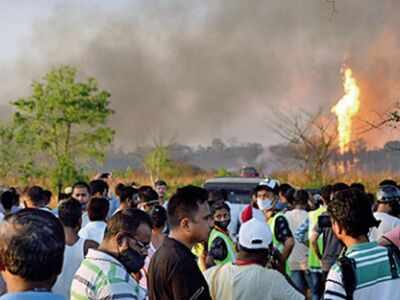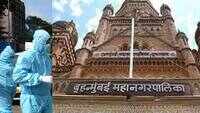
GUWAHATI: The bodies of two firemen of Oil India Limited, who were missing since an oil well at the company’s Baghjan oilfield in Assam’s Tinsukia district exploded on Tuesday afternoon, were recovered from a nearby pond by National Disaster Response Force (NDRF) personnel on Thursday morning.
The two deceased employees of OIL have been identified as Durlov Gogoi and Tikheswar Gohain. Official sources said the duo were on duty at the site when the well exploded. A third fireman was injured but was admitted to hospital on Tuesday.
Because of the inferno, it was impossible for anyone to go in the vicinity of the burning well yesterday and so there was no scope for search and rescue operations. "The oil condensate at the surface burnt out and now the surrounding areas have become visible," the source said.
Since the blowout on May 27, crude oil and natural gas has been continuously gushing out and OIL authorities after exhausting its own means, have hired the services of Singapore-based firm M/s Alert Disaster Control to cap the oil well. The Tuesday incident occurred at around 1.30pm when the three experts from ALERT were at the site.
OIL authorities said, "Post the incident, emergency meetings are under way with ALERT Team, they have expressed that it is now a safe environment for working and are confident that the situation can be controlled and the well can be capped safely. The situation demands arrangement of large quantities of water, installation of high discharge pumps and removal of debris. All the operations as per ALERT will take about 4 weeks. Efforts will be made to reduce this timeframe as much as possible."
The fire is still raging and has engulfed nearby residential areas forcing over 1,600 families to flee their homes. The Baghjan oil field blowout is threatening the environment as well. The blowout occurred at a producing well number 5, which is situated in the vicinity of Dibru Saikhowa National Park, a biodiversity hotspot and Maguri-Motapung Beel, which is home to migratory birds.
The two deceased employees of OIL have been identified as Durlov Gogoi and Tikheswar Gohain. Official sources said the duo were on duty at the site when the well exploded. A third fireman was injured but was admitted to hospital on Tuesday.
Because of the inferno, it was impossible for anyone to go in the vicinity of the burning well yesterday and so there was no scope for search and rescue operations. "The oil condensate at the surface burnt out and now the surrounding areas have become visible," the source said.
Since the blowout on May 27, crude oil and natural gas has been continuously gushing out and OIL authorities after exhausting its own means, have hired the services of Singapore-based firm M/s Alert Disaster Control to cap the oil well. The Tuesday incident occurred at around 1.30pm when the three experts from ALERT were at the site.
OIL authorities said, "Post the incident, emergency meetings are under way with ALERT Team, they have expressed that it is now a safe environment for working and are confident that the situation can be controlled and the well can be capped safely. The situation demands arrangement of large quantities of water, installation of high discharge pumps and removal of debris. All the operations as per ALERT will take about 4 weeks. Efforts will be made to reduce this timeframe as much as possible."
The fire is still raging and has engulfed nearby residential areas forcing over 1,600 families to flee their homes. The Baghjan oil field blowout is threatening the environment as well. The blowout occurred at a producing well number 5, which is situated in the vicinity of Dibru Saikhowa National Park, a biodiversity hotspot and Maguri-Motapung Beel, which is home to migratory birds.

Coronavirus outbreak
Trending Topics
LATEST VIDEOS
City
 Jyotiraditya Scindia and his mother test positive for Covid-19, admitted to Delhi hospital
Jyotiraditya Scindia and his mother test positive for Covid-19, admitted to Delhi hospital  Umar Khalid's aide Khalid Saifi taken under police custody for his role in Delhi anti-Hindu riots
Umar Khalid's aide Khalid Saifi taken under police custody for his role in Delhi anti-Hindu riots  Mumbai: 55-year-old senior BMC officer dies of Covid-19
Mumbai: 55-year-old senior BMC officer dies of Covid-19  All students to be promoted, Tamil Nadu Class 10 board exams cancelled
All students to be promoted, Tamil Nadu Class 10 board exams cancelled
More from TOI
Navbharat Times
Featured Today in Travel
Quick Links
Kerala Coronavirus Helpline NumberHaryana Coronavirus Helpline NumberUP Coronavirus Helpline NumberBareilly NewsBhopal NewsCoronavirus in DelhiCoronavirus in HyderabadCoronavirus in IndiaCoronavirus symptomsCoronavirusRajasthan Coronavirus Helpline NumberAditya ThackerayShiv SenaFire in MumbaiAP Coronavirus Helpline NumberArvind KejriwalJammu Kashmir Coronavirus Helpline NumberSrinagar encounter
Get the app



